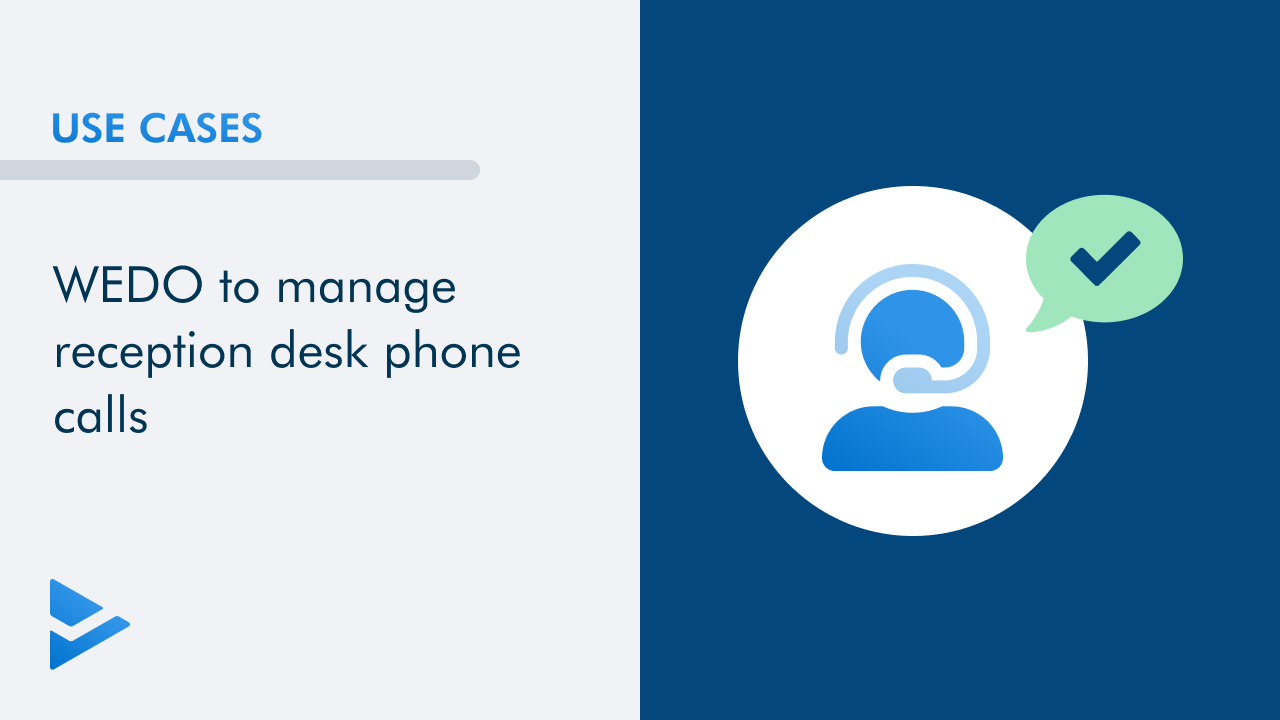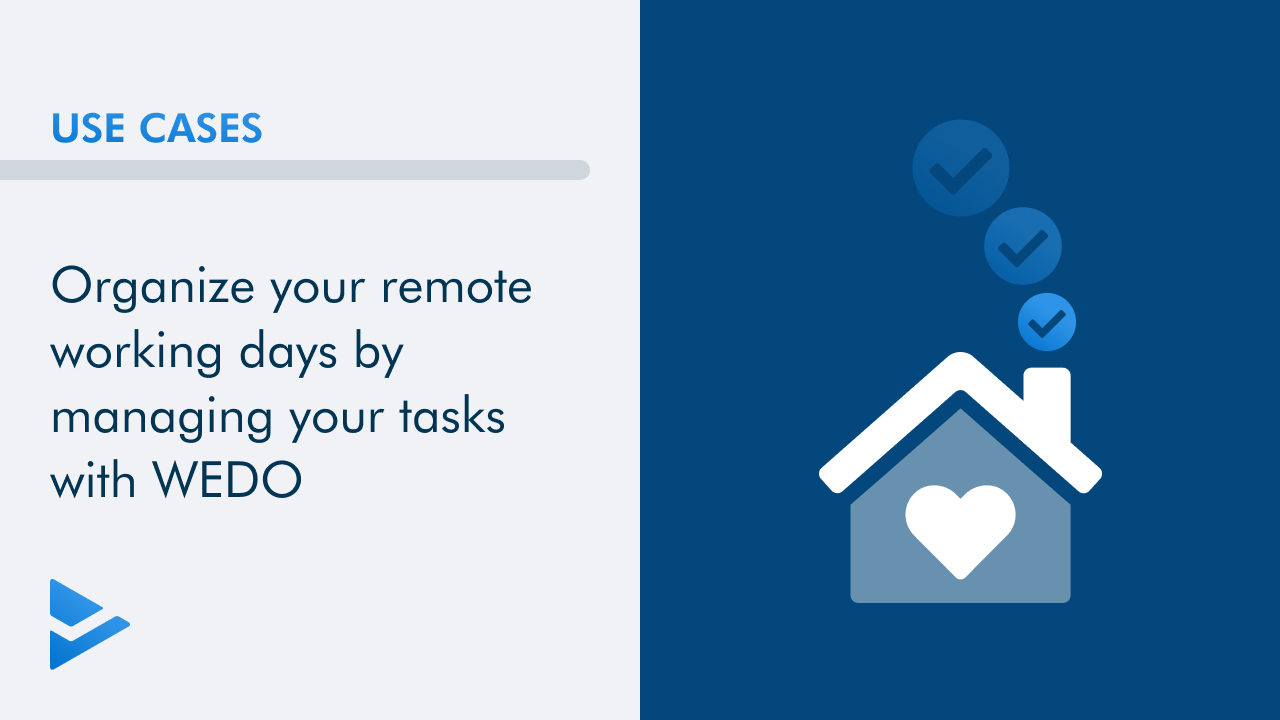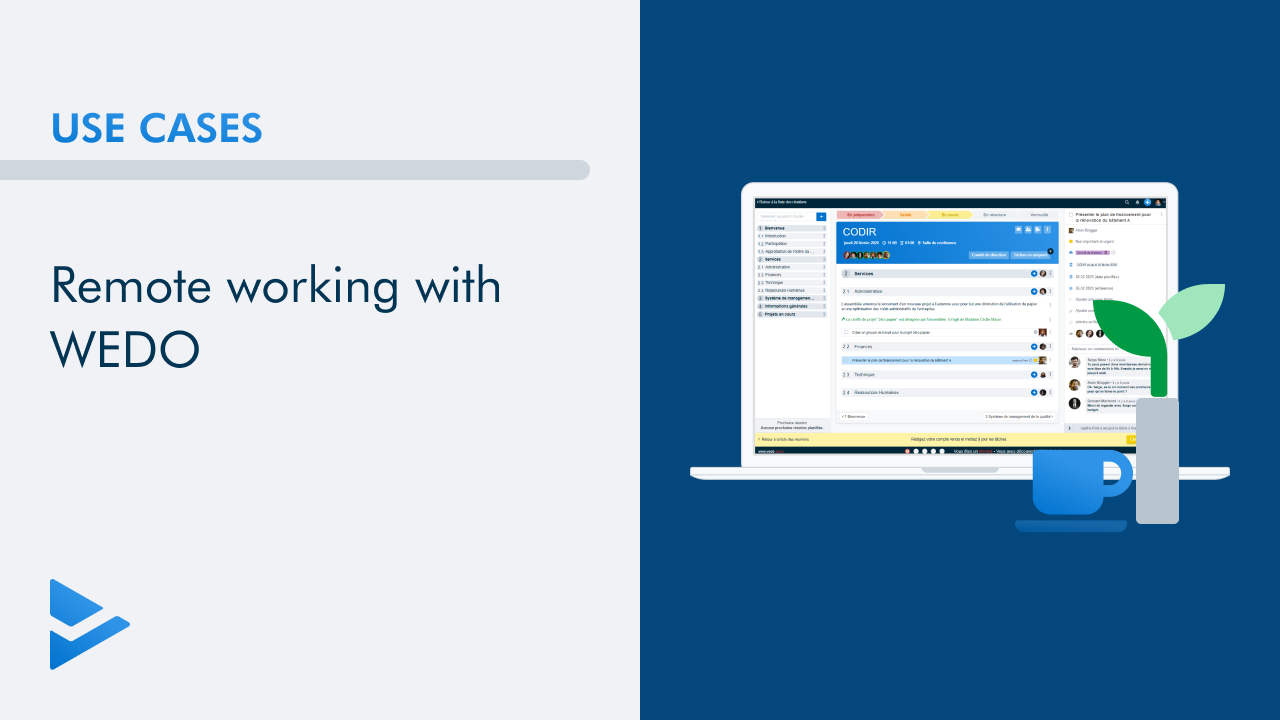Register for our next webinar !
What are the challenges of organization committees?
Often formed by volunteers, sometimes dependent on employees, associations often face the same challenges as traditional organizations: task management, preparation of meetings, project follow-up, organization of events, exchange of documents, all important and fundamental organizational issues for their proper operation.
To date, WEDO is used by a couple of associations of this type: the ArtMur association, which organizes the ArtiChoke Festival, the Estival Open air committee, the APPA - (Association for the Promotion of Aeronautical Heritage) or the Swiss Association of Executives (ASC, Swiss Leaders) collaborate with WEDO. But what are the main organizational challenges of these different entities?
- Like a traditional organization, associations often manage recurring meetings - preparation, minutes writing and follow-up of meetings are central elements;
- They also organize annual general assemblies;
- They are formed by various committees that collaborate in meetings or projects;
- They have to carry out recurring procedures that concern different members;
- They regularly share important documents that all members must know about;
- Finally, they must engage members to be dynamically involved in the work of the association.
Now that the challenges are identified, let's discover together how WEDO tackles the daily challenges of associations in order to facilitate the collaboration and engagement of their members. To simplify the understanding of the subject, we have used the example of the ArtiChoke committee, which organizes a bi-annual urban art festival thanks to WEDO.
Manage your committee and board meetings with our solution
Prepare your meetings as a team
We can't say it enough, but a poorly prepared meeting often ends in disaster. At the end of the meeting, the participants find themselves without objectives, without clear decisions and above all not knowing what tasks need to be done before the next meeting. So, like a professional organization, an association must prepare its meeting to ensure its effectiveness. But what needs to be done before the meeting? Let's discover the different key steps to prepare the agendas of your meetings.
Recurring or irregular meetings?
First, create a recurring meeting or one that repeats irregularly so that you have a serie and template for upcoming meetings. The ArtiChoke committee, for example, takes place at an irregular frequency. They therefore add their meetings as they go, but still take advantage of the recurring thematic option as the items on the agenda are often identical from one meeting to another.

Define the agenda: create sections and topics
Now, it’s time to list the agenda items for the committee, using sections in order to operate a logical grouping of the topics. Within the framework of the ArtiChoke committee, the agenda includes topics that are usually repeated each meeting, with a few exceptions. You can download the ArtiChoke committee's agenda template, which you can adapt to your needs:
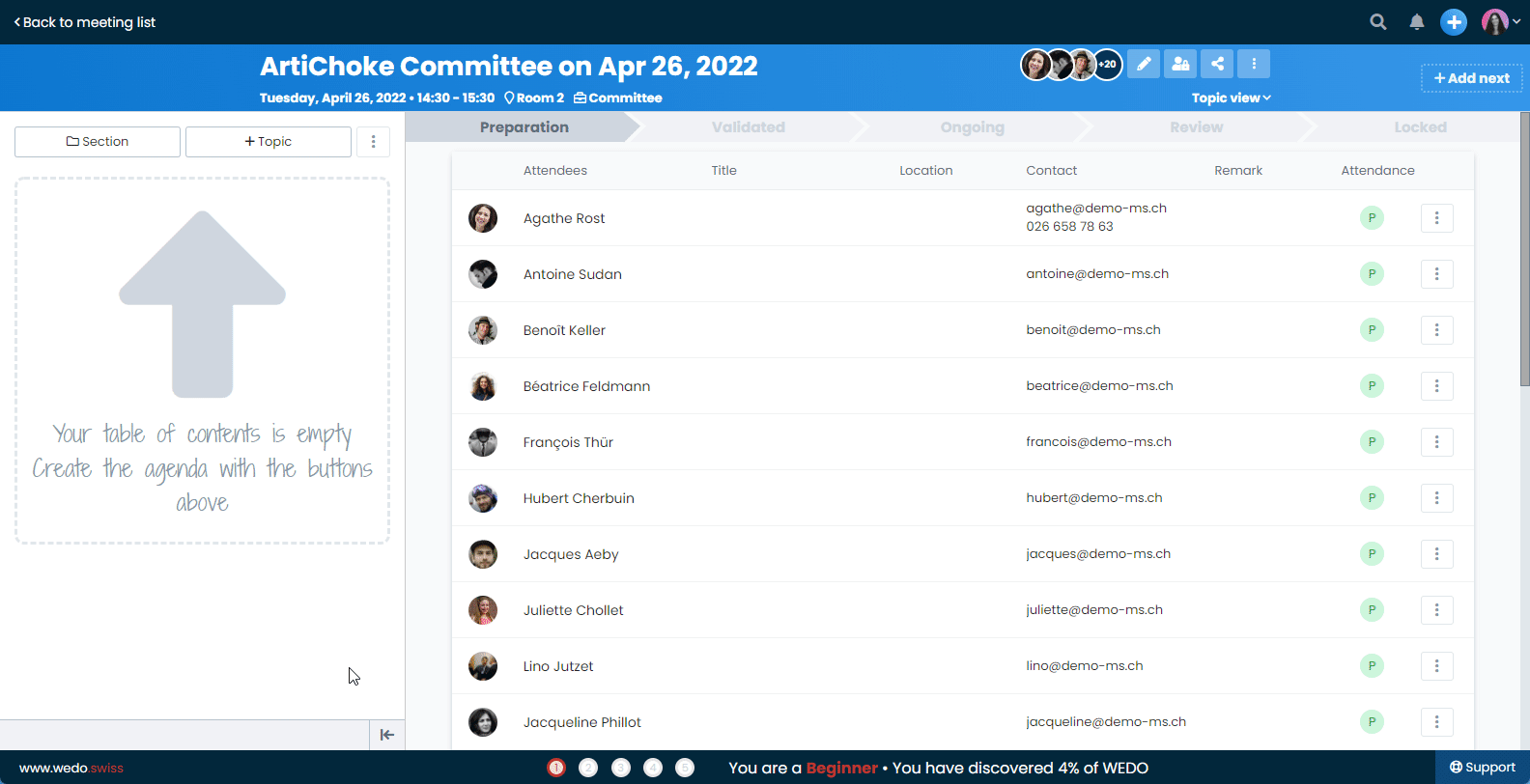
Then, directly define the topics that are recurrent and must be added to the agenda of each meeting. Here is the example for the case of the ArtiChoke committee, most of the topics are recurring:
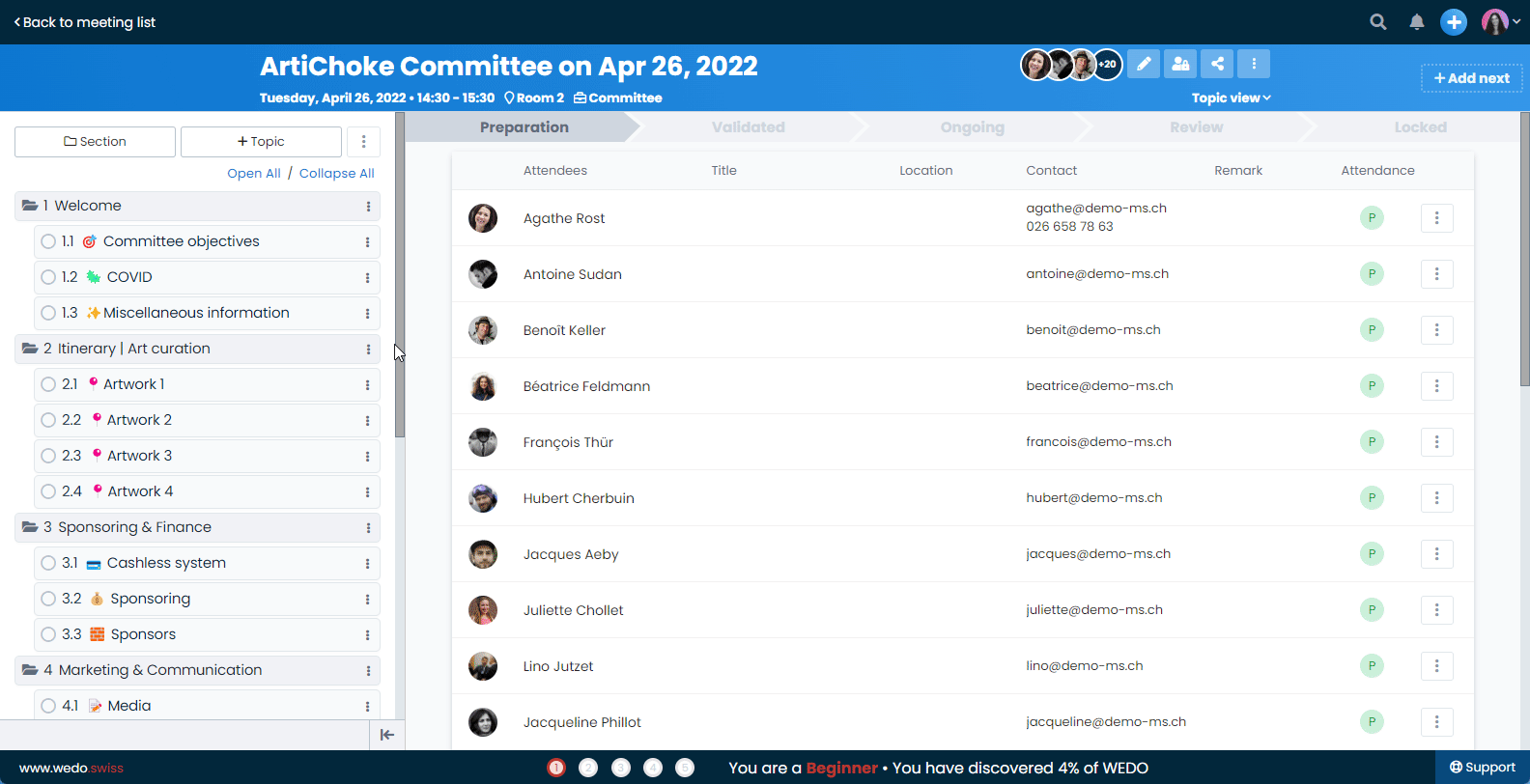
Appointing the presenters of the topics
Would you like to appoint the people in charge of the various departments in your association as presenters of the different topics on your agenda? Do it in a few clicks in order to make the participants aware of the different items for which they are responsible and which they will have to prepare. You can assign one or more persons in charge. These will of course be taken up at the following meetings if they are recurring topics.
The ArtiChoke Committee presents topics often with several leaders because it is formed by departments with a large number of members. Some points are presented only by the president in charge of leading the committee.

Customize your agenda
If you want to bring a more playful aspect to your agenda, know that WEDO interprets emoticons and you can therefore add some, as shown in the case of the ArtiChoke committee. 😃🚀
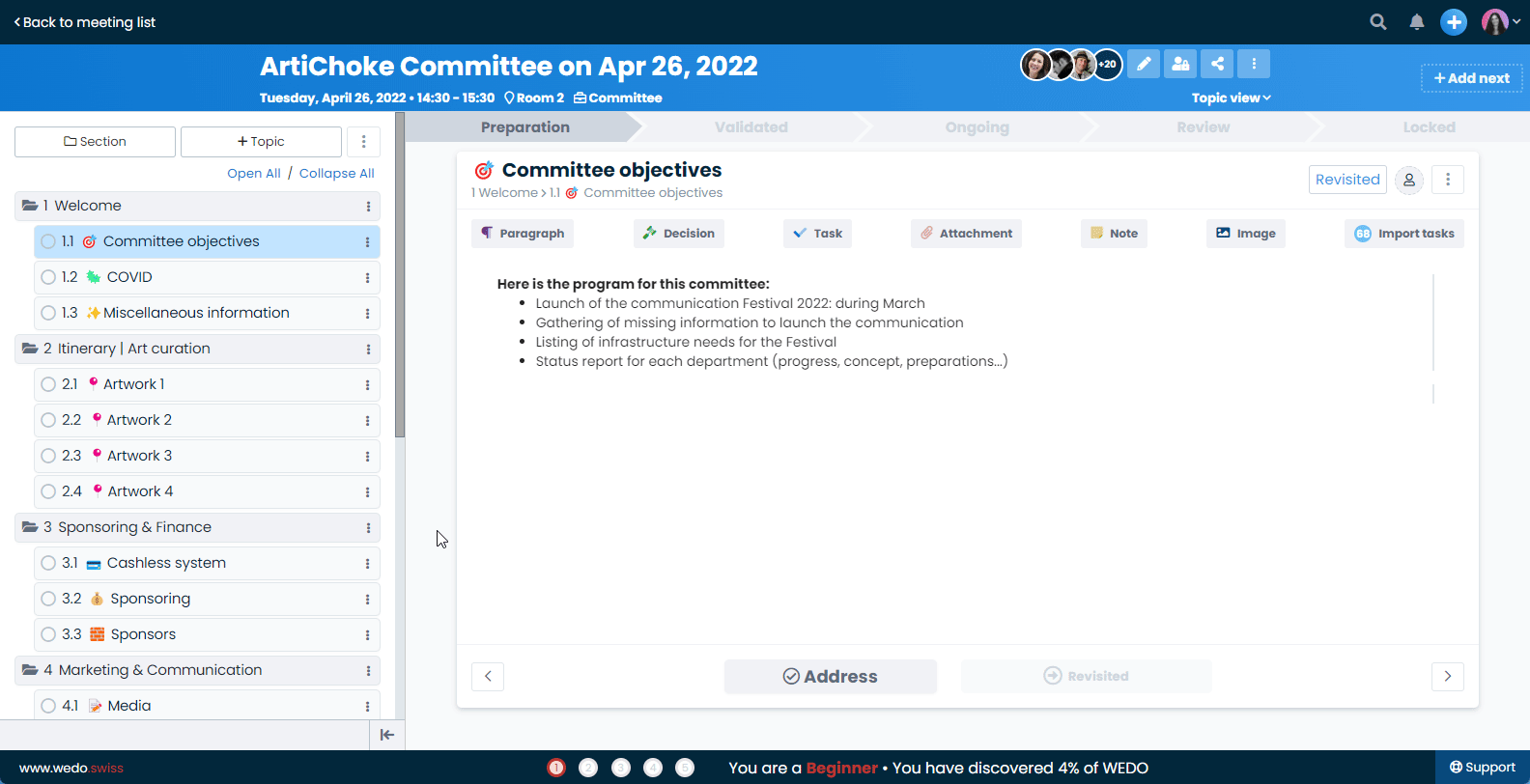
Send the agenda by email
Is your agenda ready to be completed by your members? Send them an email directly via WEDO to invite them to feed the agenda in preparation for the meeting. Participants will be able to add the topics they want to talk about, the files to share, the tasks and possibly their private notes. It is not easy to make an agenda dynamic, but if the members have made the effort to prepare their contribution in advance, they will necessarily be more engaged on the day of the meeting.
For its part, the ArtiChoke Committee has various departmental officials who speak at each meeting to report on the progress of their committee's tasks.

Dynamic minutes writing
After preparing and then validating the agenda, arrives on D-Day, it is time to write the minutes directly in WEDO. Associations can also do attendance checks, decide on decisions taken, delegate the tasks to be done and project on the screen all files on which members exchange. Let's find out together how WEDO helps you in this crucial step. We take again the example of the ArtiChoke Committee which makes its meetings dynamic thanks to WEDO.
The Chair follows the agenda outline
Throughout the meeting, the committee chair follows the previously established agenda so as not to lose the track of the meeting and, above all, to progress in a logical manner, avoiding getting lost in unlisted topics. They navigate from topic to topic, always having in mind the content that had been prepared beforehand. This way, the process is efficient and avoids any random distractions that would prolong the duration of the meeting. Many associations are managed by volunteers who give their time freely, so it is important to remain efficient and concise as much as possible!

The secretary writes the minutes in real time
The writing is done in real time and dynamically thanks to WEDO. Together with the president, the secretary feeds the topics with paragraphs, decisions, tasks and files in order to directly compose the body of the minutes. She navigates the agenda through the table of contents or navigation buttons and decides on the various items to mention whether they are treated or to be reviewed.

What is particularly useful is the instant task delegation. Indeed, at the end of the meeting, the members will be ready to work since they will discover the different tasks that were assigned to them during the meeting in their personal space. They will be able to go back to the meeting in one click to recall the exchanges and decisions that lead up to the task. Thanks to WEDO, the absent members will also be able to easily read the minutes of the committee once the secretary has sent the validated minutes by email.

Members follow the draft on the screen
The ArtiChoke committee also takes the advantage of projecting the minutes through a projector so that each member can see the minutes live. This sharing also facilitates the distribution of various presentation documents such as slides or other files that need to be shown to all the participants. With WEDO, everyone looks in the same direction and you avoid losing your members who sometimes hide behind their computer.
Management of the different departments using workspaces
Beyond the management of the central committee, WEDO offers the possibility for each department to organize and manage its tasks and meetings with workspaces. Within the scope of the ArtiChoke committee, teams have been organized with workspaces. Each team represents a department and each workspace a committee:
- First of all, there is the ArtiChoke Committee team, which includes all the members of the association. The team has four workspaces, two of which are dedicated to the organization of meetings: Committees and General Assembly.
- Then, the City Ambiance team has different commissions for which a workspace has been created: _Animations, Bars, Decorations, Market & Foodtrucks and Music & Scene_s.
- A team is dedicated to the organization of the Festival Volunteers.
- The Finance team includes the Budget and Sponsoring areas.
- Logistics is in charge of Permits, Infrastructure and Mobility.
- And finally the Marcom team is in charge of Marketing & Communication, Social Medias and Website.
The general committees are therefore added to the Committee workspace, for example. But each committee has the possibility to create its own meetings and to share tasks via its specific space. This is also the strength of WEDO! To allow each team to organize itself in a dynamic and independent way.
Finally, you should know that a workspace can also represent a Project with a start and an end date. For example, the ArtiChoke committee sometimes manages mini projects that look like events. Also, they create a dedicated space for a Project Launch or an Afterwork to organize. The idea is again to add the members in charge of organizing the project so that they can organize meetings and tasks while sharing any files that are relevant to the project.

Use checklists to organize recurring events or workflows
The latest features that can be very useful for an association are templates and checklists. Indeed, these allow you to model a recurring workflow and launch checklists from it each time the series of tasks will be performed.
Within the framework of the ArtiChoke committee, the members of the commissions have created models for carrying out the following workflows:
- Preparation bars - listing of the material to be prepared for each bar of the Festival. Here are some tasks as examples: prepare the cleaning set, print price list, laminate price list, provide ice cube tray, buy disinfectant gel, appoint a bar manager, appoint supply managers, print consumption prohibitions for minors, etc.
- Organization vernissage procedure to be carried out during the preparation of an event to inaugurate a new work of the itinerary. Here are some tasks as examples: set a vernissage date, inform the owner, inform the artist, inform the authorities, prepare an animation, organize a bar, prepare the communication, write to the local newspapers, prepare give-aways, etc.
- Application for authorization - needs to be carried out during each edition for authorizations related to the event such as patents. Here are some examples of tasks: fill out the form, create the documents to attach, attach the documents, notify the police, etc.

WEDO is best for associations
After reading this article, it is clear that WEDO has many advantages for the association environment. Although the central element is perhaps the strength of a collaborative tool for the organization of meetings, we also note how useful the platform can be for each committee to progress in a dynamic and autonomous way. The checklist feature adds an extra dimension and allows to maintain the templates to be regularly used. This will also allow the introduction of new members who will only have to be added to the checklist template or to the workspaces to learn about the tasks to be done. The same goes for the minutes of previous meetings, which can be accessed by new members in just a few clicks!
WEDO allows associations to organize their meetings and manage the work of the committees through a user-friendly and intuitive platform. You want to test our tool for your committee or your association project? Don't hesitate to contact us and start a free and non-binding trial today!
Download ArtiChoke's agenda template and adapt it to your needs.
Related posts
Get the latest tips sent straight to your inbox: Subscribe to our newsletter
Mathilde Sudan

